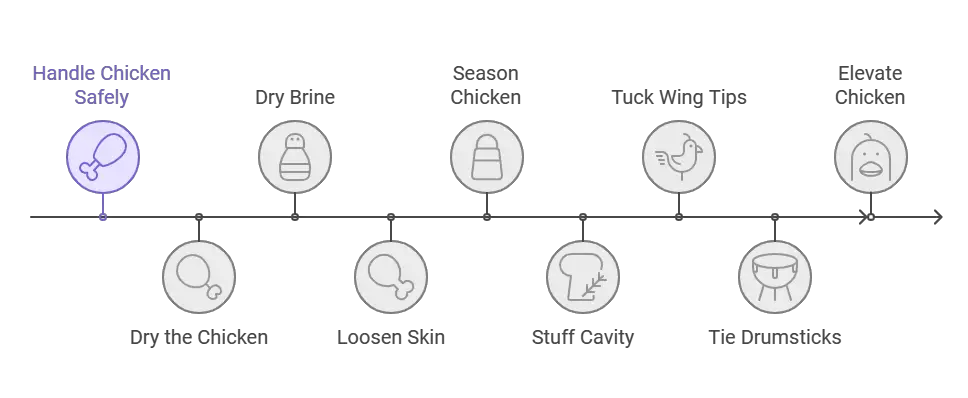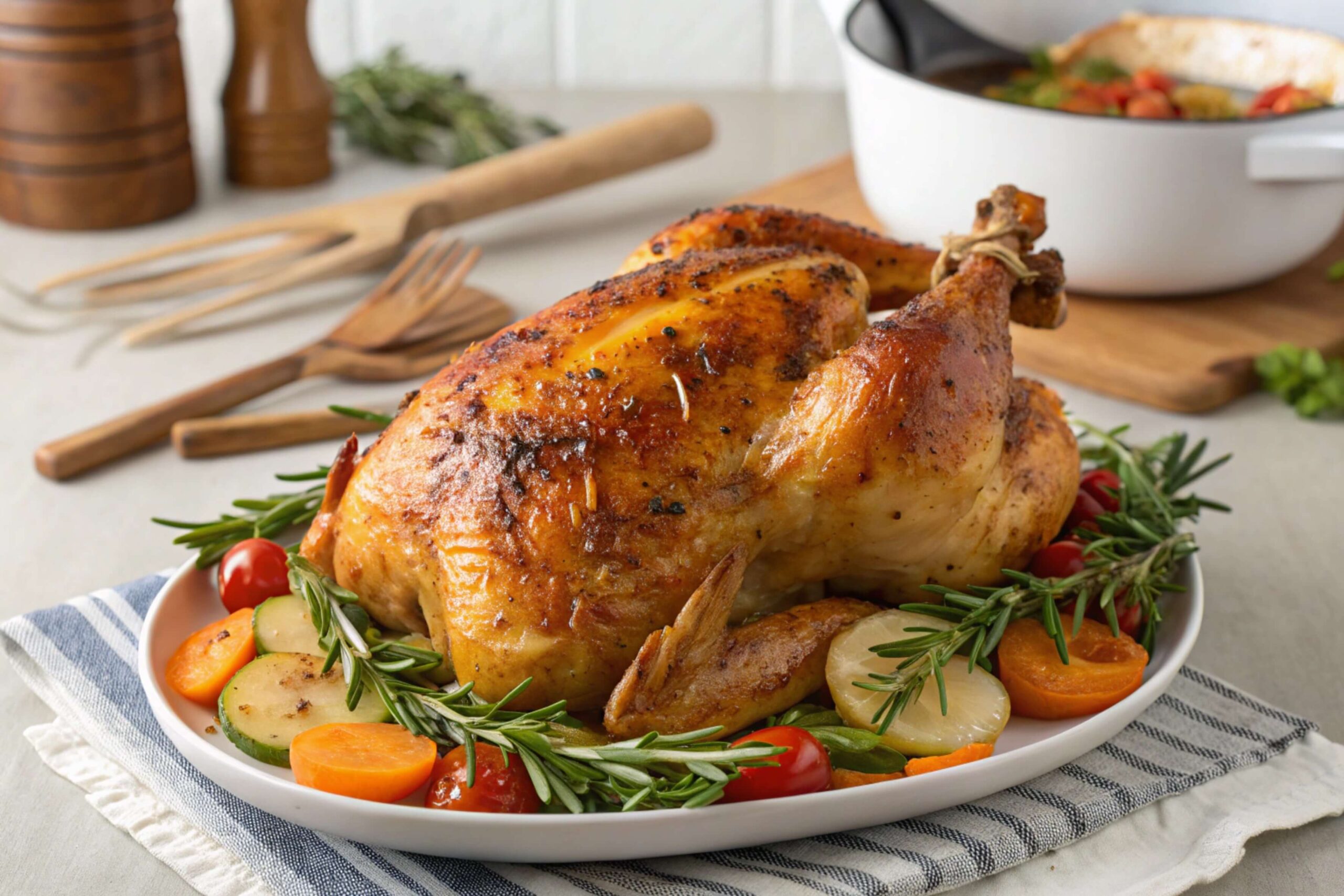want to listen to the recipe ?

Roast chicken is one of my favorite meals to make. It’s a classic dish, perfect for a simple family dinner or a special occasion. In this guide, I will share everything I’ve learned about roasting a chicken, from choosing the right ingredients to carving it perfectly. I’ll cover techniques and tips, and I promise you’ll be able to make a perfect roast chicken every single time.
Why Roast Chicken?
Roast chicken is a staple for good reason. It’s a classic dish in many cultures and it is incredibly versatile. You can serve it as a casual meal or as the centerpiece of a holiday feast. It is also healthy because it is a great source of protein. There is nothing better than a home cooked roast chicken dinner, and I want to show you how to make it.
Ingredient Selection: Choosing the Right Chicken
The size of the chicken matters. Here’s how to choose:
- A 1.5kg/3lb 5oz chicken will serve about 4 people.
- A 3-pound chicken will serve about 6 people.
- A 4-pound chicken will also serve about 6 people.
- A 5-6 pound chicken will serve about 8 people.
Chicken breeds can affect flavor and cooking time. Look for air-chilled chickens for better skin quality and less water. I suggest you use a standard roasting chicken for most purposes.
I usually buy fresh chicken, but frozen works too. Just make sure it is fully thawed before you roast it.
Essential Ingredients
Here’s what you’ll need for a basic roast chicken:
- The Chicken: Choose a whole chicken, the size depends on how many people you need to serve.
- Fats: I prefer butter. Some recipes also use margarine, or olive oil.
- Aromatics:
- Salt and pepper are essential for flavor.
- Onion and carrots placed under the chicken will add flavor to the pan juices and keep the chicken from sticking.
- Lemon halves or wedges will help flavor the chicken from the inside.
- Fresh thyme, rosemary, and other herbs will add to the overall aroma of the dish.
- A whole or halved garlic bulb or garlic cloves will contribute to the flavor.
- A single stalk of celery is sometimes used to add moisture.
- Onion powder is a flavorful seasoning.
- Liquids: Some recipes include white wine or chicken broth.
- Optional Ingredients:
- Flour is necessary if you want to make gravy from the pan drippings.
- Other herbs, spices, or seasonings can be added to taste.
[woo_product_slider id=”3030″]
Preparation: Getting Ready to Roast

First, always handle raw chicken safely. Remove the giblets, rinse the chicken inside and out, and pat it dry. Make sure to dry the skin thoroughly with paper towels for a crisper result.
Sometimes I will dry brine the chicken, which means salting the chicken in advance. This helps the skin get nice and crispy.
Next, I loosen the skin with a dessert spoon without tearing it. This allows you to add more flavor and help keep the meat moist. I like to season the cavity with salt and pepper. I also make sure to season both inside and outside the chicken. I place butter under the skin for extra flavor.
I like to stuff the cavity with lemon, herbs, and garlic. Sometimes I add celery to add moisture.
To avoid burning, I will tuck the wing tips under the body of the chicken. I tie the drumstick ends with kitchen string, which helps the chicken to cook evenly.
Elevate the chicken by placing it on a bed of vegetables or onions. This helps the chicken cook more evenly, prevents it from sitting in its own juices, and allows the flavors to infuse into the pan juices.
For best results, take the chicken out of the fridge about an hour before cooking to bring it to room temperature.
Roasting Techniques
Oven temperatures matter! Here’s a breakdown:
- Some recipes call for 190C/fan 170C/gas 5 for 1 hr 20 mins.
- Others use 350 degrees F (175 degrees C) for 1 hr 15 mins to 2 hours.
- I often start with high heat like 220C/450F for 10 minutes, then turn it down to 180C/350F.
- Some prefer 425 degrees F (220 degrees C) for 50 to 60 minutes.
Adjust cooking time based on the size of the chicken. A good guide is to start with 10 minutes at 220C/450F, then 20 minutes for every 500g/1lb at 180C/350F.
I use a roasting pan or a baking sheet with a rack. Basting is optional, and I have found that it is not necessary. Turning is also not needed.
Check for doneness by using an instant-read thermometer. It should read 165°F or 74°C in the thigh. The juices should run clear, and the meat should no longer be pink at the bone.
Making the Gravy
The “liquid gold” pan juices are amazing. For a simple gravy, I place the roasting tin over a low flame and stir in 1 tbsp of flour to make a paste. Then I gradually whisk in 250ml chicken stock until it thickens. I simmer for a couple of minutes and season to taste. Finally, I strain the gravy for a smooth consistency and add extra juices from the chicken after I carve it.
Resting and Carving
It’s important to rest the chicken for 15-20 minutes before carving. This helps the juices redistribute, ensuring a juicy result. I use tongs to carefully lift the chicken from the pan. Then, I slice the chicken onto a platter and serve it with the pan juices or gravy.
Sides and Pairings
Here are some great side dishes to serve with roast chicken:
- Roasted potatoes
- Mashed potatoes
- Roasted vegetables, like carrots or butternut squash
- Salads
- Stuffing
For wine, I like a crisp white or light red wine.
Troubleshooting Common Issues
If your chicken is undercooked, make sure it reaches 165°F in the thickest part of the thigh. To avoid uneven cooking, use a rack or a bed of vegetables. For soggy skin, try using a higher initial heat. To avoid burnt garlic, put it under the skin instead of on top.
Global Variations of Roast Chicken
Roast chicken is enjoyed around the world. Different cultures use different seasonings, marinades, and cooking methods. It’s fun to explore these variations.
Utilizing Leftovers
I store leftover chicken in an airtight container in the refrigerator for up to four days. Reheat the chicken in the oven or microwave. I like to use leftover chicken in salads, sandwiches, soups, and omelets.
The carcass is great for making a homemade broth, which I then use for soups. I add water, vegetables, and herbs and simmer it for a few hours.
Conclusion
Roasting a chicken is simple, rewarding, and so delicious. By using these tips and techniques, you can make a perfect roast chicken every time. I hope you’ll try it out. And let me know how it goes by leaving a comment below!


